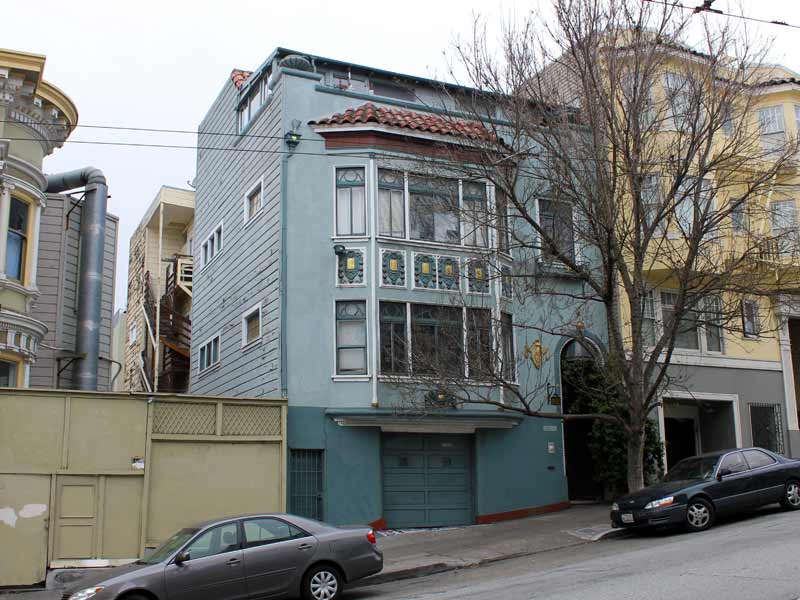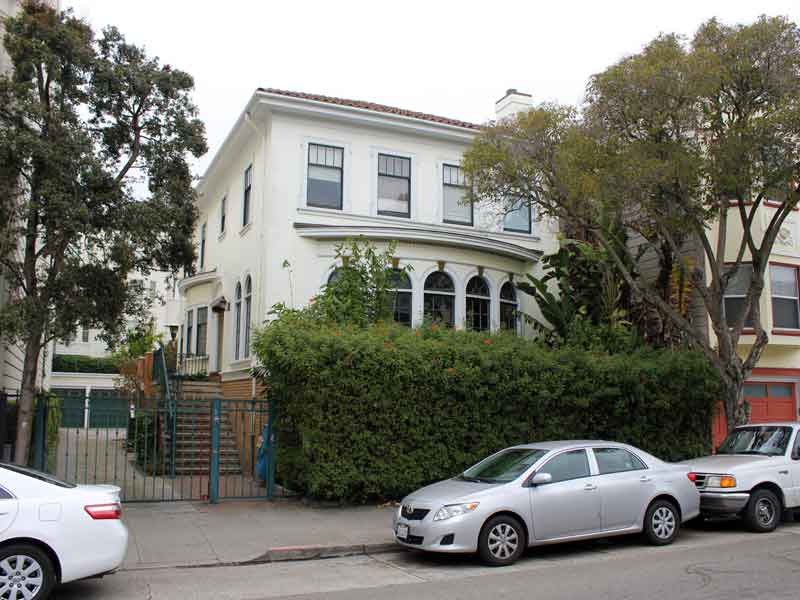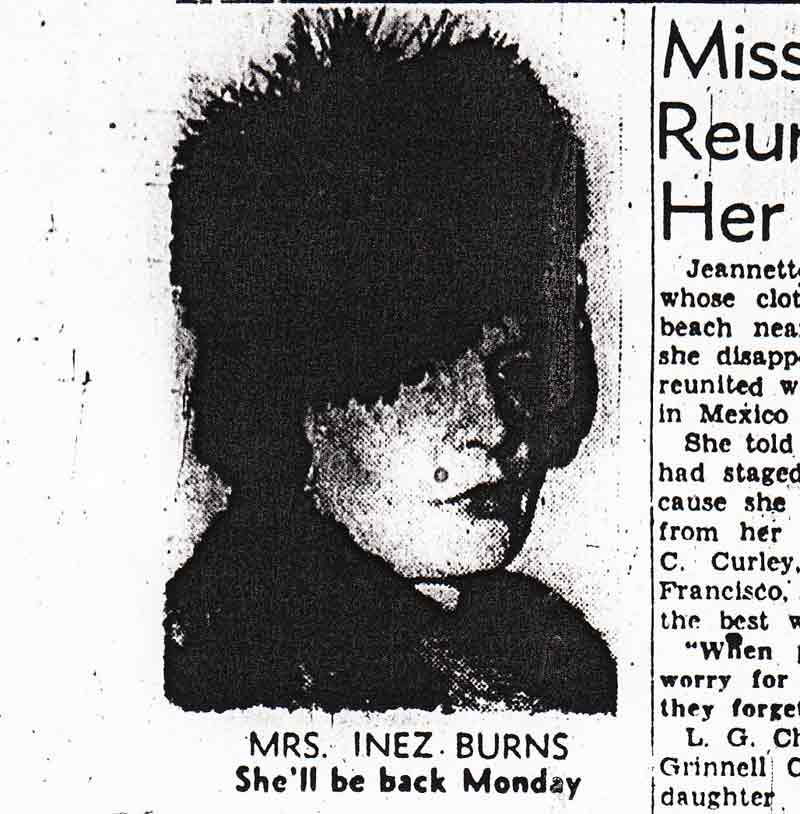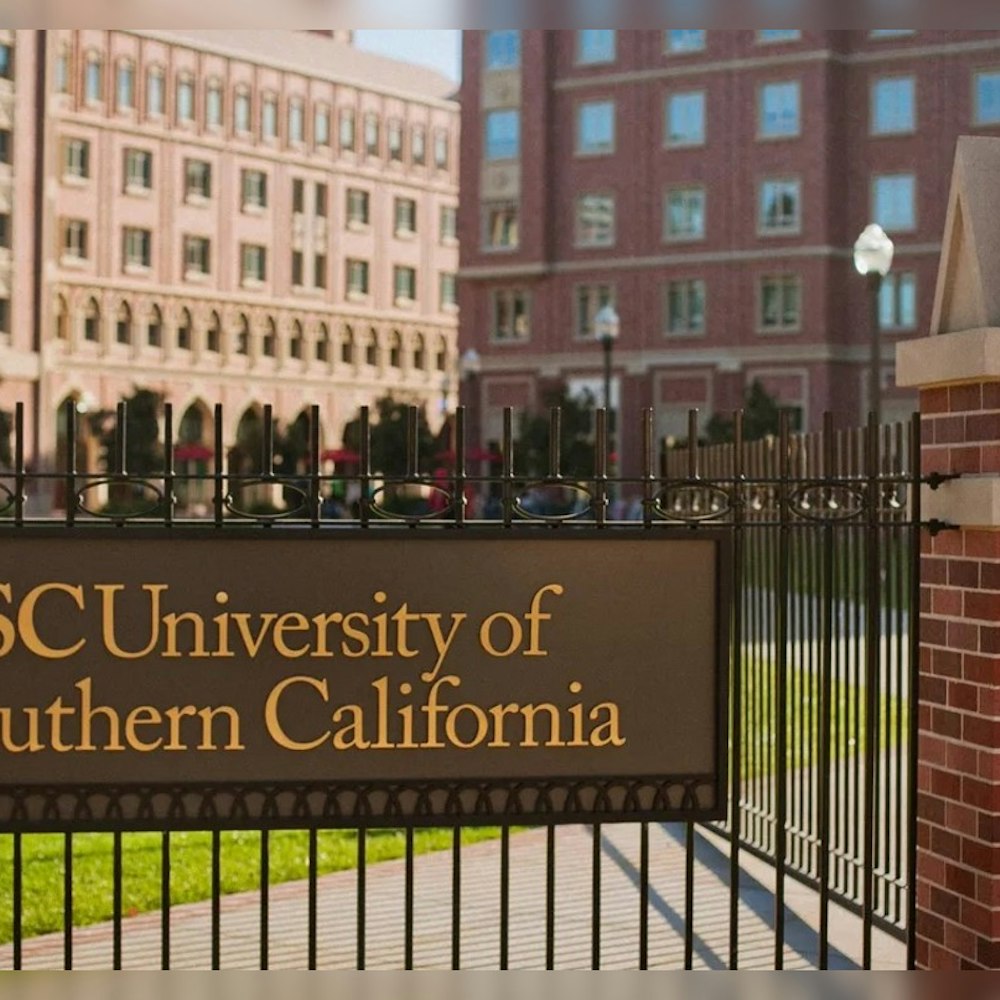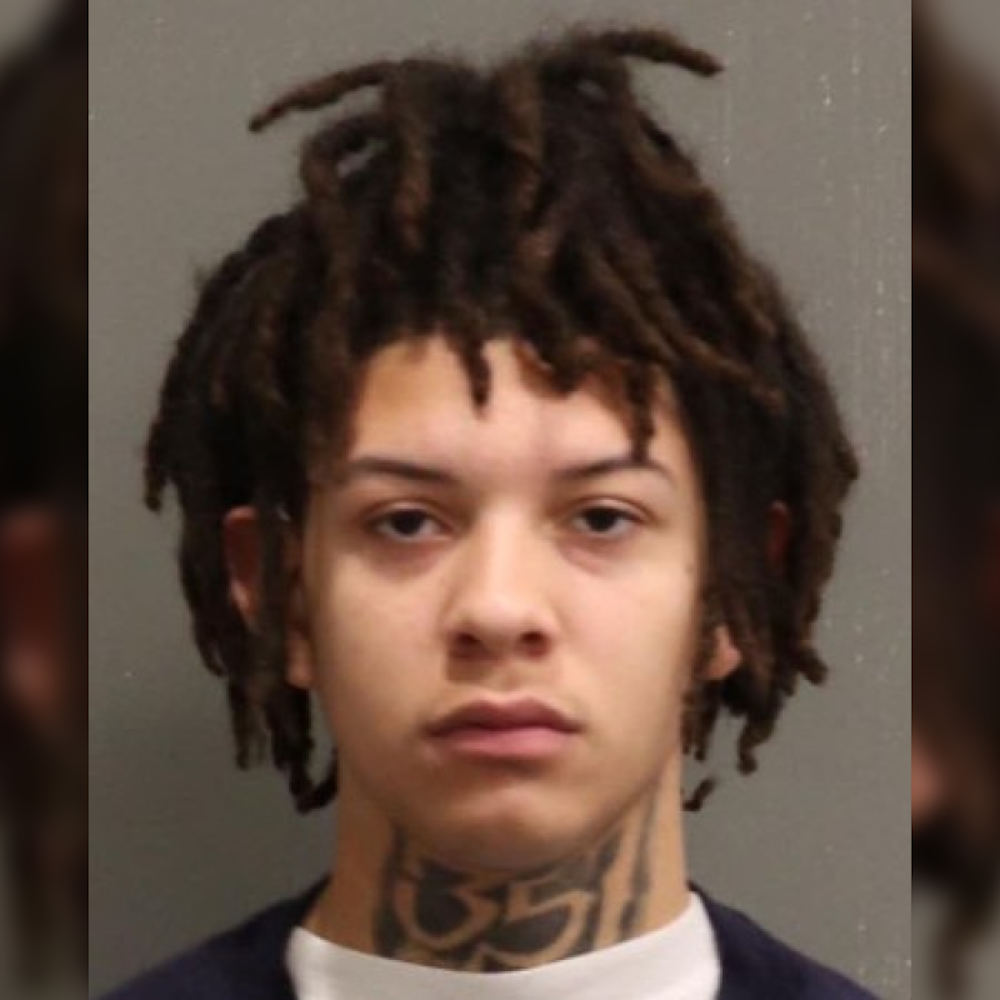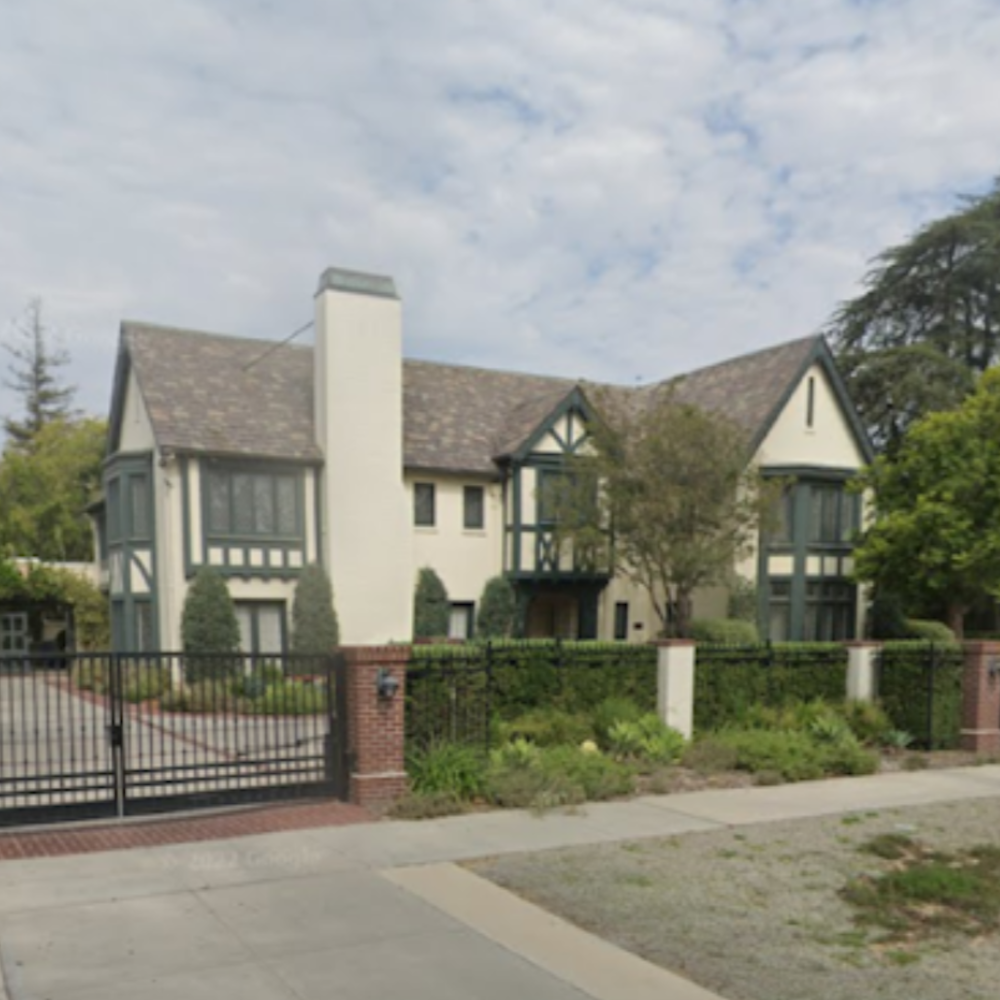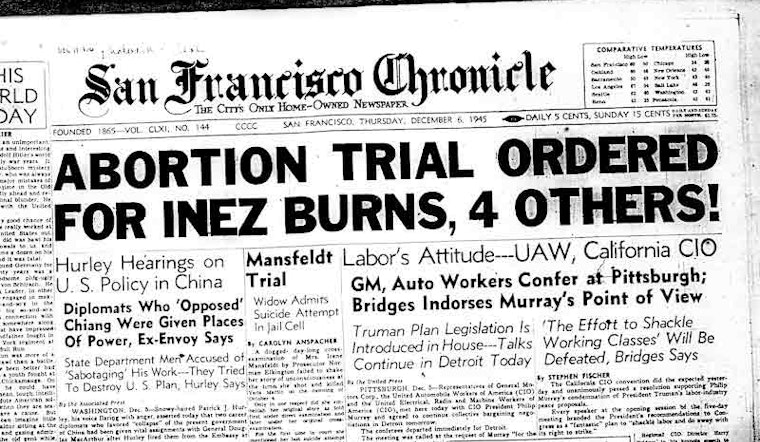
We've got something special for you today -- the story of the biggest scandal ever to rock the Lower Haight.
It involves a clandestine abortion hospital, a manhunt for a runaway Supervisor, a tell-all book, secret passageways, shakedowns and tip-offs, Rita Hayworth, late-night underground poker games, Jerry Brown's father, and three sensational trials which went all the way to the Supreme Court. And it's all because of what went on here, just a few feet north of the intersection of Haight and Fillmore: So, clear your schedule for a few minutes and join us for a story that's almost too amazing to believe, won't you?
Note: the following story is compiled from accounts in various newspapers, the article San Francisco's Worst Kept Secret by Stephen G. Bloom, and June Morall's Half Moon Bay Memories. Historical photos are courtesy of the SF Public Library unless otherwise stated.
Our story begins in Philadelphia in 1889, with the birth of a girl named Inez Brown. Inez was born into a poor family, and by all accounts her childhood was difficult. At a young age, she was forced to quit school to work in a pickle factory. Her father abandoned the family when Inez was just a few years old, leaving her mother to raise her and her three siblings. When Inez was a teenager, her mother remarried, and the family moved to San Francisco. There, Inez got a job working as a manicurist at the Palace Hotel. Described as striking and shapely, Inez quickly garnered many regular male customers eager to take advantage of her manicuring services. One of these men was an elderly physician by the name of Dr. West. He was a full-time abortionist, and he would change the course of Inez's life.
In the early 20th Century, abortion was illegal in nearly every U.S. state, including California, except when necessary to save a woman's life. There were also strict birth control laws on the books at the time. As such, unwanted pregnancies were common, and illicit abortions were in high demand. The practice was a felony, but unless a woman died, the doctors and midwives who performed it were rarely arrested. Inez Brown herself is believed to have had several abortions performed by Dr. West, the physician she met at the Palace Hotel. Over the course of their interactions, West apparently took a liking to Inez, and eventually offered her a job at his clinic. She accepted. Inez shadowed West at the clinic for a year, learning how to perform the practice. By her mid-thirties, Inez had recognized the lucrative service as something she was capable of doing on her own. So, in 1922, she opened her own abortion clinic, in a two-story flat at 327 Fillmore Street. Inez hired several assistants to help her -- nurses, a janitor, and a blood technician. She outfitted multiple rooms with beds for recovering patients; another was transformed into an operating room, replete with surgical instruments, bowls, and basins. She had trap doors installed, mindful that the illegal operation might someday necessitate a quick getaway. In the backyard, she installed large concrete incinerators for disposing of fetal remains. In a reception room, patrons could help themselves to one of Inez's business cards from a copper bowl. The cards described her only as a "Designer." Inez ran the business cleanly and efficiently, and it quickly flourished. Her patients included wealthy socialites, politicians' wives, prostitutes and nuns. She would perform up to 30 abortions a day, at a cost of between $75 and $200 per abortion. At her peak, she was making $50,000 per month - about $625,000 in today's dollars. Over the next decade, she would rake in millions, becoming one of the wealthiest women in California. It was also a decade of personal growth for Inez. In 1924, with money already pouring in, Inez was able to build herself this house at 274 Guerrero Street, constructed to her unique specifications: Inez designed the house with various secret compartments where she could store cash earned from the abortion business. She also bought property outside of San Francisco, including a home in Atherton and a 1,000-acre ranch in Half Moon Bay. In 1932, Inez married a California Assemblyman named Joseph Burns. She took his name, thereafter going by "Inez Burns," though occasionally she used the alias "Amy Dutch." Things were going quite well for Inez up until July 11, 1936 -- the day that police first raided 327 Fillmore Street.
327 Fillmore Street was again raided. This time, San Francisco police, led by Frank Ahern, seized a handful of notebooks filled with names, dates, and dollar amounts. The notes indicated that Burns had performed half a million dollars' worth of abortions in 1944 alone. Inez and seven of her employees were charged with conspiracy to commit abortions and violations of state medical laws. A grand jury was convened to hear the charges. Inez Burns pleaded not guilty to the charges against her. The grand jury, in considering whether to indict Inez, heard the testimony of one 20-year-old woman who had received an abortion at the clinic. No one else agreed to testify. The grand jury refused to indict her, citing insufficient evidence. But Brown, now seemingly on a crusade, didn't give up. Instead, he spent the next month building a case against her. He gathered new evidence, including receipts for oxygen, ether, and other anaesthetics seized during the most recent raid. Also seized was Inez's purse, which contained a note bearing the names of two of the policemen assigned to the investigation. This discovery seemingly supported Brown's theory that Inez had been tipped off about the raid. With the new ammunition, Brown had Inez arrested again on slightly modified charges on October 27, 1945. This time, Brown revealed more details from Inez's seized notebooks, including the fact that she may have had several "notable" patients. As Brown said at the time:
A pre-trial hearing began on November 26th, 1945. During the hearing, three women from Oakland were questioned by Assistant District Attorney Thomas Lynch. They each told of visits to the clinic: being buzzed in, walking upstairs to the waiting room, and being admitted to see "Doctor Burns." Another witness, a shipping clerk for a surgical device company, said he delivered equipment to the address, and recognized two of the defendants. Several other deliverymen testified similarly. When it was Inez's time to defend herself, her attorney, James F. Brennan, dropped a bombshell.
The preliminary hearing concluded with no sign of the Shannons, and thus no chance for Inez's attorney to pursue her biggest line of defense: that the whole case was motivated by the Shannons' failed blackmail attempt. On December 5, 1945, a trial was ordered for Inez Burns and four other defendants. Charges against two remaining employees of the hospital were dismissed for lack of evidence. The Shannons, meanwhile, had still not returned to San Francisco. District Attorney Brown considered issuing subpoenas to force them back to the city. However, he refused to do so without a formal complaint from Inez. And Inez's lawyer, James Brennan, wouldn't allow her to speak with Brown, for fear of tipping their hand in the case. Therefore, there was no way for Brown to force the Shannons to return. Two more weeks went by. Finally, on December 17, 1945, Pat Brown got a phone call. It was the Shannons. They had left Bakersfield, but had not returned to San Francisco. Instead, they had driven to Mexico. Gloria Shannon, it turns out, had been writing a book. It was a tell-all documenting the goings-on at the abortion hospital upstairs, and it had a stunning title:
In January of 1946, a grand jury again met to consider the new trial of Inez Burns and her four co-defendants. During the preliminary hearing, several issues were considered -- the operation of the abortion hospital, whether Inez Burns was tipped off by police before the September 26th raid, and the blackmail claim against the Shannons. Brown seemed to be particularly focused on the possibility of police corruption. He was incensed that at least two police officers, and the brother of Police Chief Charles Dulles, attended regular weekly poker games at the Burns's house. They were friends with her husband Joe, having grown up together on the mean streets of the Mission. Inez Burns didn't see anything wrong the game nights. "So some policemen came," Inez Burns said. "And Ed Dulles? Well they're friends of ours. Joe's known them for years. It's too bad we can't have a little game of cards." Meanwhile, Police Commissioner Jerd Sullivan didn't appreciate the implication that police were cozy with Burns and her husband. "If he's got anything, he ought to take it to the Grand Jury," Sullivan said. "I've told 'Buster' Brown before that if he has a beef, the Grand Jury is the place to take it." But Brown stuck to his guns. "Any time you have something illegal running in a city for a long period of time -- say 20 or 30 years -- someone is being paid off."
The retrial began soon after the end of the first trial, and went largely the same way. The prosecution brought out dozens of witnesses and exhibits; the defense offered no defense. McGovern again closed by claiming the case was political. Lynch countered thusly:
The third trial began on September 19, 1946. Before the trial, McGovern met with Pat Brown and Tom Lynch to discuss a plea deal. They came to an agreement that Burns and her co-defendants would plead guilty to lesser charges, pay a fine, and avoid jail time. All they needed to seal the deal was the judge's approval. The judge refused. This outraged McGovern, who accused the judge of bias. The judge was sensitive to the accusation and recused himself, and a new judge, Edward P. Murphy, took his place. Murphy was determined to conduct the case properly. He immediately had the jury sequestered -- something that hadn't been done in the city in 30 years. They were holed up in the Whitcomb Hotel, with three deputy sheriffs assigned to protect them from outside contact. Also stepping things up for this trial was Assistant District Attorney Tom Lynch, who had a surprise up his sleeve. On the afternoon of September 24th, he summoned an unexpected witness to the stand. "Call Mrs. Queen," he said. In walked Lavina Queen, the nightgown-clad anesthetist who had escaped over her back fence when police tried to question her nearly a year earlier. Described as an "attractive, chic brunette," Queen captivated the courtroom. Since her fence-hopping escape, Queen had spent stints in New York, Miami, Haiti, and Rio de Janeiro. She knew there was a warrant for her arrest in California, but returned when Lynch indicated he'd be willing to drop the charges in exchange for her testimony. And her testimony was damning. She described the inner workings of the abortion clinic in great detail. For years, she said, the clinic would treat between 20 and 40 patients per day. She claimed to have witnessed Inez Burns performing abortions "all the time," and even described the exact procedure of the operations. Again, McGovern offered no defense. Closing arguments began the next day, and they played out similarly to the first two trials. But with the added testimony of Lavina Queen, Lynch had a stronger hand this time. Inez Burns's luck finally ran out on September 26th, 1946. The jury voted to convict all five defendants on charges of conspiracy to commit abortions and of practicing medicine without a license.
Inez and her co-defendants were sentenced to 2 to 5 years each in state prisons. The four women would be sent to Tehachapi Prison near Bakersfield; the one male to San Quentin. When the sentences were read to a packed courtroom, all five defendants -- including Inez Burns -- burst into tears. McGovern declared that he would appeal the convictions, and he did -- though he came up with a unique basis for his argument. During the trial, one of the jurors had been discovered to be facing hit-and-run driving charges. The judge replaced him with an alternate. McGovern's appeal was based on the premise that this constituted double jeopardy, as the defendants were effectively being tried by a second jury. The case was appealed to the State Appellate Court, which refused to reverse the conviction. Then, it was appealed to the California Supreme Court, which refused even to review it. Finally, after nearly two years of appeals, the case reached the U.S. Supreme Court. On October 26, 1948, the Court announced that it had decided not to review the conviction. The appeals process was officially over. Burns and her co-defendants, who had already been sent to prison, would have to serve out the remainder of their sentences.
The successful conviction of Burns and her cohorts catapulted many of the trial's key players to higher office. Police Inspector Frank Ahern earned the nickname "Honest Frank" for refusing to accept the alleged bribe from Inez Burns's Guerrero Street safe. He would continue to work his way up the ranks, eventually being named Chief of Police in 1956. His service in the role would be short-lived, though. Ahern died from a heart attack at a Giants/Dodgers game in 1958. In the 15th inning, with the score tied and the bases loaded, Giants right-fielder Willie Kirkland attempted to steal home. The crowd went wild, and Ahern lept to his feet -- then clutched his chest and collapsed. He was pronounced dead minutes later at the stadium's first aid station.
Tom Lynch, the assistant D.A., later became District Attorney, and then, in 1964, Attorney General. In 1968, he ran for president as a Democrat. He placed third in the 1968 Democratic primary, behind Robert F. Kennedy and Eugene McCarthy. Lynch died in San Francisco in 1986 at the age of 82.
Pat Brown, the District Attorney, continued to make a name for himself as a crusader against immorality, cracking down on bookies and bordellos throughout San Francisco. In 1950, he was elected Attorney General of California, and served two terms. Then, in 1958, he ran for Governor, and won. He was reelected in 1962, defeating Richard Nixon. His political career finally came to an end in 1966 when he was defeated for a third term, losing to Ronald Reagan. Brown's son Jerry, who was born a month before the 1938 raid on the Fillmore Street abortion clinic, would assume the role of Governor just a few years later, being elected in 1974 and again in 2010. Pat Brown died in 1996. In a telephone interview shortly before his death, he was asked about the Inez Burns case. "I had the zeal of a new D.A.," he said. "I was looked at as a fighting D.A., and the rest of the state thought that was good." As for Inez, Brown remembered her as "a very good abortionist with a good reputation. Everyone thought she was a necessary evil. But when I became D.A. her business had become flagrant."
Inez Burns served two years and seven months at Tehachapi Women's Prison. But she continued to face legal troubles after her release. She was convicted of tax evasion in 1951, and again in 1952 for performing another abortion. She was sent back to prison for another 14 months. Then, in 1956, she was forced to settle with the IRS, paying more than $740,000 in back taxes. Inez had become bitter and reclusive by this point. She would stare out the window of her Guerrero Street home, intimidating neighbors with an angry glare. In 1971, five years before her death, Inez was interviewed about abortion. California had legalized the practice in 1967, and Roe v. Wade was, at that time, pending before the Supreme Court. Rather than joy or vindication, Inez expressed dismay at the trend toward legalization.
It involves a clandestine abortion hospital, a manhunt for a runaway Supervisor, a tell-all book, secret passageways, shakedowns and tip-offs, Rita Hayworth, late-night underground poker games, Jerry Brown's father, and three sensational trials which went all the way to the Supreme Court. And it's all because of what went on here, just a few feet north of the intersection of Haight and Fillmore: So, clear your schedule for a few minutes and join us for a story that's almost too amazing to believe, won't you?
Note: the following story is compiled from accounts in various newspapers, the article San Francisco's Worst Kept Secret by Stephen G. Bloom, and June Morall's Half Moon Bay Memories. Historical photos are courtesy of the SF Public Library unless otherwise stated.
Our story begins in Philadelphia in 1889, with the birth of a girl named Inez Brown. Inez was born into a poor family, and by all accounts her childhood was difficult. At a young age, she was forced to quit school to work in a pickle factory. Her father abandoned the family when Inez was just a few years old, leaving her mother to raise her and her three siblings. When Inez was a teenager, her mother remarried, and the family moved to San Francisco. There, Inez got a job working as a manicurist at the Palace Hotel. Described as striking and shapely, Inez quickly garnered many regular male customers eager to take advantage of her manicuring services. One of these men was an elderly physician by the name of Dr. West. He was a full-time abortionist, and he would change the course of Inez's life.
In the early 20th Century, abortion was illegal in nearly every U.S. state, including California, except when necessary to save a woman's life. There were also strict birth control laws on the books at the time. As such, unwanted pregnancies were common, and illicit abortions were in high demand. The practice was a felony, but unless a woman died, the doctors and midwives who performed it were rarely arrested. Inez Brown herself is believed to have had several abortions performed by Dr. West, the physician she met at the Palace Hotel. Over the course of their interactions, West apparently took a liking to Inez, and eventually offered her a job at his clinic. She accepted. Inez shadowed West at the clinic for a year, learning how to perform the practice. By her mid-thirties, Inez had recognized the lucrative service as something she was capable of doing on her own. So, in 1922, she opened her own abortion clinic, in a two-story flat at 327 Fillmore Street. Inez hired several assistants to help her -- nurses, a janitor, and a blood technician. She outfitted multiple rooms with beds for recovering patients; another was transformed into an operating room, replete with surgical instruments, bowls, and basins. She had trap doors installed, mindful that the illegal operation might someday necessitate a quick getaway. In the backyard, she installed large concrete incinerators for disposing of fetal remains. In a reception room, patrons could help themselves to one of Inez's business cards from a copper bowl. The cards described her only as a "Designer." Inez ran the business cleanly and efficiently, and it quickly flourished. Her patients included wealthy socialites, politicians' wives, prostitutes and nuns. She would perform up to 30 abortions a day, at a cost of between $75 and $200 per abortion. At her peak, she was making $50,000 per month - about $625,000 in today's dollars. Over the next decade, she would rake in millions, becoming one of the wealthiest women in California. It was also a decade of personal growth for Inez. In 1924, with money already pouring in, Inez was able to build herself this house at 274 Guerrero Street, constructed to her unique specifications: Inez designed the house with various secret compartments where she could store cash earned from the abortion business. She also bought property outside of San Francisco, including a home in Atherton and a 1,000-acre ranch in Half Moon Bay. In 1932, Inez married a California Assemblyman named Joseph Burns. She took his name, thereafter going by "Inez Burns," though occasionally she used the alias "Amy Dutch." Things were going quite well for Inez up until July 11, 1936 -- the day that police first raided 327 Fillmore Street.
The First Raids
Cops stormed the makeshift hospital and arrested two employees, a maid and a janitor, on charges of being "vagrants." Inez herself escaped charges though, and the clinic was not shut down.
Then, two years later, in May of 1938, the clinic was raided again.
This time, a patient had informed police that Inez herself had performed the illegal operation on her. Inez and one of her nurses, Margie Silver, were arrested. During the raid, police questioned 10 women in the clinic's bedrooms, all of whom denied having had abortions and refused to cooperate.
The case against Inez and Margie was dismissed just a few weeks later, as police were unable to get any of the clinic's customers to swear to complaints against the women.
Inez managed to dodge prosecution partly because of her customers' loyalty, and partly because she was shrewd about not leaving a paper trail. She kept no detailed records of her operations, and stored almost all of her money in secret compartments and safes rather than bank accounts.
She did, however, face tax evasion charges in 1939, which she settled the next year after paying a $10,000 fine. As the Chronicle reported at the time:
'Her trial was marked by much argument and a few caustic comments from the bench as to the courtroom secrecy of Mrs. Burns's "profession."'Inez would refer to the Fillmore flat as a "convalescent home," but its status as an abortion hospital was becoming widely known. Still, she was able to keep the operation going well into the 1940s. Then, in 1943, San Francisco got a new District Attorney. His name was Pat Brown, and he ran a campaign promising to clean up the city. Specifically, he vowed to eradicate rampant police corruption. Almost instantly after being elected, he turned an eye toward the case of Inez Burns.
September, 1945
On September 23, 1945, a young woman checked into San Francisco's Central Emergency Hospital. She needed treatment for the lingering side-effects from a recent abortion.
Police were called to the hospital to question her, and she told them she had received the abortion at Inez Burns's clinic.
The next day, undercover police were posted outside 327 Fillmore Street. They were instructed to watch for any activity that would corroborate the young woman's claim.
They saw none.
The Chief of Police was unconvinced. Two days later, he ordered a raid on the clinic.
Police raced to Fillmore Street on the morning of September 26th, arriving at 9:40am. Inez Burns was nowhere to be found.
Just five minutes earlier, police were told, she had hurried out of the flat with her husband and another woman. Inez was carrying a package containing documents and office records. The trio hopped into a waiting limousine, and quickly drove away.
Police Inspector Frank Ahern, the lead officer on the case, was furious. He immediately drove to Inez's Guerrero Street home. There, he found her and one of her alleged accomplices.
Inside the home, police discovered a safe containing $289,217 in cash -- or about $3.6 million in today's dollars. It also contained a piece of paper, which Inez unsuccessfully tried to swallow, seemingly detailing her extensive revenue.
Brown notified the Internal Revenue Department of the discovery. Inez Burns was immediately arrested.
327 Fillmore Street was again raided. This time, San Francisco police, led by Frank Ahern, seized a handful of notebooks filled with names, dates, and dollar amounts. The notes indicated that Burns had performed half a million dollars' worth of abortions in 1944 alone. Inez and seven of her employees were charged with conspiracy to commit abortions and violations of state medical laws. A grand jury was convened to hear the charges. Inez Burns pleaded not guilty to the charges against her. The grand jury, in considering whether to indict Inez, heard the testimony of one 20-year-old woman who had received an abortion at the clinic. No one else agreed to testify. The grand jury refused to indict her, citing insufficient evidence. But Brown, now seemingly on a crusade, didn't give up. Instead, he spent the next month building a case against her. He gathered new evidence, including receipts for oxygen, ether, and other anaesthetics seized during the most recent raid. Also seized was Inez's purse, which contained a note bearing the names of two of the policemen assigned to the investigation. This discovery seemingly supported Brown's theory that Inez had been tipped off about the raid. With the new ammunition, Brown had Inez arrested again on slightly modified charges on October 27, 1945. This time, Brown revealed more details from Inez's seized notebooks, including the fact that she may have had several "notable" patients. As Brown said at the time:
"Our investigation has revealed that a number of prominent persons have shown more than an ordinary interest in the operation of this establishment."It's a statement that Inez would not deny. She would later claim such figures as actresses Rita Hayworth and Lana Turner among her customers. The promise of the exposure of such boldfaced names made Inez's arrest, and the trial that followed, front-page news for months to come. In announcing more details about Inez's clientele, Brown also said that police were seeking one fugitive witness -- a woman named Lavina Queen. Queen, Burns's alleged anesthetist, escaped her Forest Hills home by jumping over a back fence in her nightgown and fur coat, while her husband argued with police at the front door. She wouldn't be found for months.
A pre-trial hearing began on November 26th, 1945. During the hearing, three women from Oakland were questioned by Assistant District Attorney Thomas Lynch. They each told of visits to the clinic: being buzzed in, walking upstairs to the waiting room, and being admitted to see "Doctor Burns." Another witness, a shipping clerk for a surgical device company, said he delivered equipment to the address, and recognized two of the defendants. Several other deliverymen testified similarly. When it was Inez's time to defend herself, her attorney, James F. Brennan, dropped a bombshell.
The Shannon Shakedown
While cross-examining a pharmacist who had made deliveries to the Fillmore street address, Brennan asked if the pharmacist knew that Warren Shannon, a former Supervisor and once acting Mayor of San Francisco, and his wife Gloria lived at the address. The pharmacist said that he did.
The mention of the Shannons surprised -- and confused -- the courtroom. The judge asked Brennan what the relevance was.
"The Shannons tried to shake these people down for $35,000," Brennan reportedly answered. "That's the motive behind this prosecution!"
The Shannons, it would later be revealed, had lived at 325 Fillmore Street, the flat downstairs from Inez's hospital, for four months in 1945. The two flats were connected by a narrow stairway concealed behind a hidden, sliding door in one of the upstairs closets. The Shannons knew about the hospital, Brennan was contending, but had demanded $35,000 from Inez to keep quiet about it. When they didn't receive the money, the Shannons tipped off the police.
It was an explosive charge leveled at a prominent San Francisco politician, and it successfully diverted attention in the case, albeit briefly, from Inez Burns to Warren and Gloria Shannon.
"There are people on trial in this case who have not done nearly as much as Mrs. Shannon did," Brennan told the court. "Why isn't she on trial? That's what I want to know!"
Frank Ahern, the police inspector, said he would track down the Shannons to determine whether there was any merit to the charge.
But he would soon find tracking down the Shannons easier said than done.
The Shannon Manhunt
That afternoon, after Brennan's explosive claim, reporters called Warren Shannon's office. They were told that he was out of town at an unknown location.
The next morning, the Shannons were spotted checking out of an Oakland hotel. Pat Brown, the D.A., requested an all-points bulletin to bring the Shannons in for questioning.
Description: Warren Shannon. Approximately 65 years old; six feet, two inches; slender build; approximately 200 pounds; one defective eye; gray thinning hair. Mrs. Warren Shannon. 165 pounds; heavy set; well dressed; dark blonde hair; steel brace on one leg; driving 1938 Buick sedan; 1945 license 2L 2838.The next day, on December 1, 1945, the Shannons were spotted in the lobby of the Padre Hotel in Bakersfield, California. They had checked into the hotel under the pseudonyms "Mr. and Mrs. Cooper of San Francisco." They hired an attorney, who told reporters, "The Shannons are not running from anything." The Shannons would voluntarily return to San Francisco to speak with the District Attorney, their lawyer said. Days went by. The Shannons did not voluntarily return to San Francisco. Meanwhile, the preliminary hearing in the Burns case continued. When Police Inspector Frank Ahern was called to testify, he leveled an additional charge at Inez Burns: attempted bribery. Ahern claimed that when police searched Inez's Guerrero Street home back in September, and discovered the safe with $289,217 inside, Inez pleaded with Ahern to keep it quiet. "Mrs. Burns asked me to take some of the money in the safe and let everything go," he testified. When Ahern made the claim, Inez Burns, who was sitting nearby with the other defendants, audibly gasped.
The preliminary hearing concluded with no sign of the Shannons, and thus no chance for Inez's attorney to pursue her biggest line of defense: that the whole case was motivated by the Shannons' failed blackmail attempt. On December 5, 1945, a trial was ordered for Inez Burns and four other defendants. Charges against two remaining employees of the hospital were dismissed for lack of evidence. The Shannons, meanwhile, had still not returned to San Francisco. District Attorney Brown considered issuing subpoenas to force them back to the city. However, he refused to do so without a formal complaint from Inez. And Inez's lawyer, James Brennan, wouldn't allow her to speak with Brown, for fear of tipping their hand in the case. Therefore, there was no way for Brown to force the Shannons to return. Two more weeks went by. Finally, on December 17, 1945, Pat Brown got a phone call. It was the Shannons. They had left Bakersfield, but had not returned to San Francisco. Instead, they had driven to Mexico. Gloria Shannon, it turns out, had been writing a book. It was a tell-all documenting the goings-on at the abortion hospital upstairs, and it had a stunning title:
"My Memoirs in the Midstream of Life After An Intimate View of San Francisco's Slaughter House for Babies."The Shannons had been eager to sell their story and expose the "monstrous abortion racket." They described themselves as "unappreciated confidential agents working for the people of San Francisco." The Mexico trip was merely a vacation, they claimed, and not a runaway attempt. They told Brown that they were now in El Paso, Texas, and were heading back to San Francisco. For real this time. Brown, however, chose to meet the Shannons halfway instead. Without telling the media or the court, he received emergency permission from the chairman of the Board of Supervisors to leave the state (apparently a legal requirement), drove to Los Angeles, stayed overnight in the Biltmore Hotel, and then continued eastward to Arizona. Meeting the Shannons outside of California would allow them to have counsel present -- a prerequisite for the discussion. Two days after the phone call, Brown and the Shannons met up in the coffeeshop of the Hotel Westward Ho in Phoenix Arizona. They talked for three hours, during which the Shannons denied asking Inez Burns for any money. But they did provide Brown with plenty of information for his case. He promised to offer them police protection if they would return to San Francisco and testify in the case. They agreed.
In January of 1946, a grand jury again met to consider the new trial of Inez Burns and her four co-defendants. During the preliminary hearing, several issues were considered -- the operation of the abortion hospital, whether Inez Burns was tipped off by police before the September 26th raid, and the blackmail claim against the Shannons. Brown seemed to be particularly focused on the possibility of police corruption. He was incensed that at least two police officers, and the brother of Police Chief Charles Dulles, attended regular weekly poker games at the Burns's house. They were friends with her husband Joe, having grown up together on the mean streets of the Mission. Inez Burns didn't see anything wrong the game nights. "So some policemen came," Inez Burns said. "And Ed Dulles? Well they're friends of ours. Joe's known them for years. It's too bad we can't have a little game of cards." Meanwhile, Police Commissioner Jerd Sullivan didn't appreciate the implication that police were cozy with Burns and her husband. "If he's got anything, he ought to take it to the Grand Jury," Sullivan said. "I've told 'Buster' Brown before that if he has a beef, the Grand Jury is the place to take it." But Brown stuck to his guns. "Any time you have something illegal running in a city for a long period of time -- say 20 or 30 years -- someone is being paid off."
The Trial Begins
The trial of Inez Burns began on February 18, 1946.
The prosecution brought out several of the clinic's employees, who testified to having seen Inez Burns, dressed in white, "working with" patients.
Inez's new defense attorney, Walter McGovern, issued a slew of objections, claiming that the employees' testimony was "an attempt to prove conspiracy by the acts and declarations of a co-conspirator." All of his objections were overruled.
An anesthetist named Madeline Rand described how Inez Burns coached her employees to deal with patients.
"She told us to tell them to rest for at least 48 hours and for a few days if they could. They were not to wash their hair for at least a week. If there were complications, they were not to contact the family doctor or anyone else, but to telephone us and come back to us."In total, Assistant D.A. Thomas Lynch called 30 witnesses before finally resting on March 6th, 1946. Then it was the defense's turn to call witnesses. But Inez's attorney Walter McGovern surprised the court by offering no defense whatsoever. "In view of the total insufficiency of the evidence, we rest, too," McGovern said. In resting without testimony, he was unable to pursue the shakedown claim against the Shannons. Instead, in his closing argument, McGovern focused on Pat Brown, claiming that the D.A.'s motives were entirely political. And he said as much directly to the jury.
"Don't let them trick you! Don't be pawns in a dirty political fight! Don't make these defendants the goats on the sacrificial altar of the political ambitions of Mr. Brown. He is using these women as a springboard to attain higher office through publicity!"After closing arguments and instructions from the judge, the jury of seven men and five women began to deliberate. Three hours later, they were deadlocked. The judge ordered them to continue deliberating. They considered the case for another four hours -- but remained deadlocked. As one point, the jury asked to see Inez Burns's notebooks, checkbooks, and records. They also asked the judge to clarify exactly who was allowed to perform abortions under the California penal code. The judge read them Section 274 of the code, which declares abortions to be a felony unless performed to save a human life. This didn't seem to entirely clarify the issue for the jurors. On the night of March 9th, the jury announced that it was hopelessly deadlocked. Eleven of the jurors were ready to convict. One juror refused. Her name was Anna Linder, a divorced mother of five. After the trial, she explained her reasoning.
"The judge said that if they were conspirators they were all guilty. I think that some were innocent and therefore I couldn't find them all guilty."Assistant D.A. Thomas Lynch immediately announced plans for a retrial.
The retrial began soon after the end of the first trial, and went largely the same way. The prosecution brought out dozens of witnesses and exhibits; the defense offered no defense. McGovern again closed by claiming the case was political. Lynch countered thusly:
"McGovern's philosophy is that it was a fine place rendering public service. Should you accept it, San Francisco would be the only community in the United States openly sanctioning the violation of the law."The jury of eight men and four women began deliberating on May 28, 1946. After about six hours, they asked the judge for a dictionary. The request was denied. The next evening, the jury announced that it, too, was hopelessly deadlocked. This time, the ratio was seven in favor of conviction versus five against. The foreman told reporters:
"The one big issue was the attitude the jury should have towards prosecution witnesses who had been labeled 'accomplices' by Judge Kaufman in his instructions to the jury."The judge had told the jury to distrust testimony from seven women who testified as having had abortions performed at the Burns clinic. The reason the jurors had asked for a dictionary, it turns out, was to look up the word "distrust." A third trial was ordered, with hearings beginning in June.
The third trial began on September 19, 1946. Before the trial, McGovern met with Pat Brown and Tom Lynch to discuss a plea deal. They came to an agreement that Burns and her co-defendants would plead guilty to lesser charges, pay a fine, and avoid jail time. All they needed to seal the deal was the judge's approval. The judge refused. This outraged McGovern, who accused the judge of bias. The judge was sensitive to the accusation and recused himself, and a new judge, Edward P. Murphy, took his place. Murphy was determined to conduct the case properly. He immediately had the jury sequestered -- something that hadn't been done in the city in 30 years. They were holed up in the Whitcomb Hotel, with three deputy sheriffs assigned to protect them from outside contact. Also stepping things up for this trial was Assistant District Attorney Tom Lynch, who had a surprise up his sleeve. On the afternoon of September 24th, he summoned an unexpected witness to the stand. "Call Mrs. Queen," he said. In walked Lavina Queen, the nightgown-clad anesthetist who had escaped over her back fence when police tried to question her nearly a year earlier. Described as an "attractive, chic brunette," Queen captivated the courtroom. Since her fence-hopping escape, Queen had spent stints in New York, Miami, Haiti, and Rio de Janeiro. She knew there was a warrant for her arrest in California, but returned when Lynch indicated he'd be willing to drop the charges in exchange for her testimony. And her testimony was damning. She described the inner workings of the abortion clinic in great detail. For years, she said, the clinic would treat between 20 and 40 patients per day. She claimed to have witnessed Inez Burns performing abortions "all the time," and even described the exact procedure of the operations. Again, McGovern offered no defense. Closing arguments began the next day, and they played out similarly to the first two trials. But with the added testimony of Lavina Queen, Lynch had a stronger hand this time. Inez Burns's luck finally ran out on September 26th, 1946. The jury voted to convict all five defendants on charges of conspiracy to commit abortions and of practicing medicine without a license.
Inez and her co-defendants were sentenced to 2 to 5 years each in state prisons. The four women would be sent to Tehachapi Prison near Bakersfield; the one male to San Quentin. When the sentences were read to a packed courtroom, all five defendants -- including Inez Burns -- burst into tears. McGovern declared that he would appeal the convictions, and he did -- though he came up with a unique basis for his argument. During the trial, one of the jurors had been discovered to be facing hit-and-run driving charges. The judge replaced him with an alternate. McGovern's appeal was based on the premise that this constituted double jeopardy, as the defendants were effectively being tried by a second jury. The case was appealed to the State Appellate Court, which refused to reverse the conviction. Then, it was appealed to the California Supreme Court, which refused even to review it. Finally, after nearly two years of appeals, the case reached the U.S. Supreme Court. On October 26, 1948, the Court announced that it had decided not to review the conviction. The appeals process was officially over. Burns and her co-defendants, who had already been sent to prison, would have to serve out the remainder of their sentences.
The successful conviction of Burns and her cohorts catapulted many of the trial's key players to higher office. Police Inspector Frank Ahern earned the nickname "Honest Frank" for refusing to accept the alleged bribe from Inez Burns's Guerrero Street safe. He would continue to work his way up the ranks, eventually being named Chief of Police in 1956. His service in the role would be short-lived, though. Ahern died from a heart attack at a Giants/Dodgers game in 1958. In the 15th inning, with the score tied and the bases loaded, Giants right-fielder Willie Kirkland attempted to steal home. The crowd went wild, and Ahern lept to his feet -- then clutched his chest and collapsed. He was pronounced dead minutes later at the stadium's first aid station.
Tom Lynch, the assistant D.A., later became District Attorney, and then, in 1964, Attorney General. In 1968, he ran for president as a Democrat. He placed third in the 1968 Democratic primary, behind Robert F. Kennedy and Eugene McCarthy. Lynch died in San Francisco in 1986 at the age of 82.
Pat Brown, the District Attorney, continued to make a name for himself as a crusader against immorality, cracking down on bookies and bordellos throughout San Francisco. In 1950, he was elected Attorney General of California, and served two terms. Then, in 1958, he ran for Governor, and won. He was reelected in 1962, defeating Richard Nixon. His political career finally came to an end in 1966 when he was defeated for a third term, losing to Ronald Reagan. Brown's son Jerry, who was born a month before the 1938 raid on the Fillmore Street abortion clinic, would assume the role of Governor just a few years later, being elected in 1974 and again in 2010. Pat Brown died in 1996. In a telephone interview shortly before his death, he was asked about the Inez Burns case. "I had the zeal of a new D.A.," he said. "I was looked at as a fighting D.A., and the rest of the state thought that was good." As for Inez, Brown remembered her as "a very good abortionist with a good reputation. Everyone thought she was a necessary evil. But when I became D.A. her business had become flagrant."
Inez Burns served two years and seven months at Tehachapi Women's Prison. But she continued to face legal troubles after her release. She was convicted of tax evasion in 1951, and again in 1952 for performing another abortion. She was sent back to prison for another 14 months. Then, in 1956, she was forced to settle with the IRS, paying more than $740,000 in back taxes. Inez had become bitter and reclusive by this point. She would stare out the window of her Guerrero Street home, intimidating neighbors with an angry glare. In 1971, five years before her death, Inez was interviewed about abortion. California had legalized the practice in 1967, and Roe v. Wade was, at that time, pending before the Supreme Court. Rather than joy or vindication, Inez expressed dismay at the trend toward legalization.
"Scores of women will die. It will be quite a while before physicians who have not been trained for this type of surgery will be able to do it well and safely."Joe and Inez Burns spent their final years in a nursing home in Moss Beach. Joe died in 1975, and Inez soon thereafter. She passed away on Sunday, January 25, 1976, at the age of 87. Despite her staggering wealth during the abortion trial, Burns was reportedly destitute at the time of her death, having lost her fortune in the tax settlement. And thus ends the story of Inez Burns -- a shrewd, successful woman at the center of a larger-than-life scandal. 327 Fillmore Street, meanwhile, remains. The trap doors were boarded up long ago, the incinerators filled with concrete. Just looking at it, as you walk down Fillmore or wait for Muni, you'd have no idea what happened here 70 years ago, just steps away from the heart of the Lower Haight.
